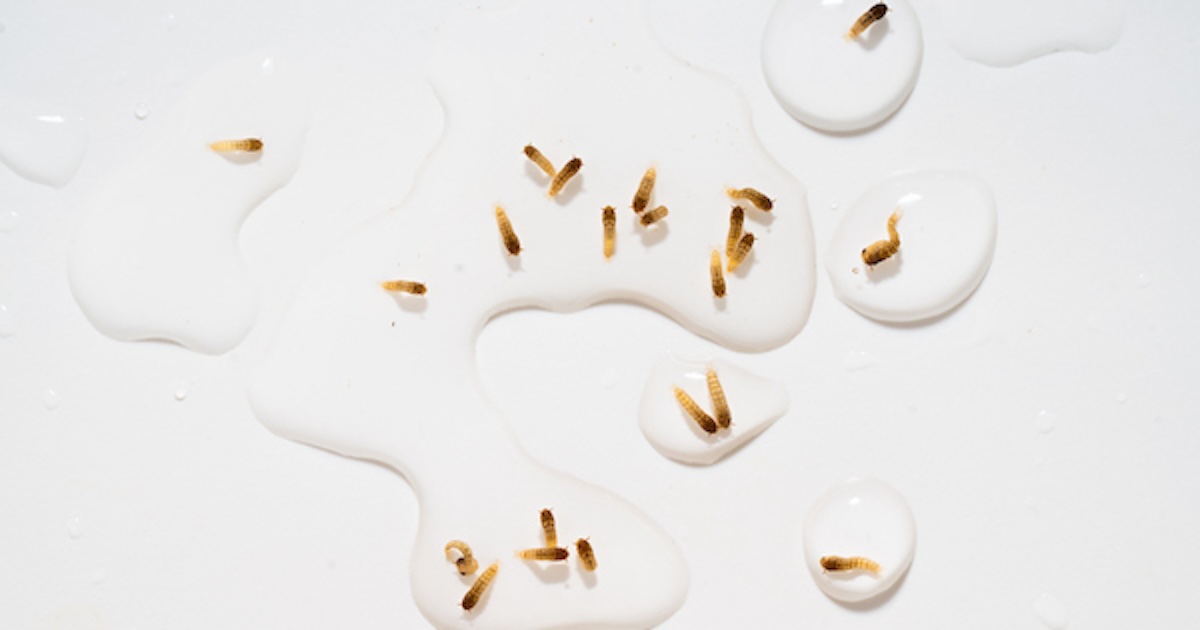Expert tips for minimizing threat of West Nile virus, other vector-borne disease
 Mosquito pupae, characterized by their round, yellow and brown bodies, are important to look for in stagnant water as Culex mosquitoes nationwide have been testing positive for West Nile virus.
Mosquito pupae, characterized by their round, yellow and brown bodies, are important to look for in stagnant water as Culex mosquitoes nationwide have been testing positive for West Nile virus. WEST LAFAYETTE, Ind. — As mosquitoes and people across the country test positive for West Nile virus (WNV), Purdue University entomologists are sharing guidance to help people prevent mosquito bites to lower their risk of infection.
"This year, WNV is a major concern, not just in Indiana but across much of the Midwest," said Phurchhoki Sherpa, medical entomology program coordinator in Purdue's Department of Entomology. "According to state Department of Health surveillance, mosquitoes are testing positive earlier than usual, which could extend the WNV season and increase the risk of human infections."
Although 80% of individuals infected with WNV never show symptoms, the remaining 20% may develop fever, headaches, body and joint aches, fatigue, swollen lymph nodes, rashes, nausea, or vomiting. In severe cases, especially in individuals over the age of 60 or those with weakened immune systems, WNV can cause inflammation in the brain, spinal cord or other parts of the nervous system. Unfortunately, there is currently no vaccine or specific treatment for WNV.
To date, a total of 433 human cases of WNV have been reported across 34 states, including 10 confirmed cases in Indiana. The Indiana Department of Health dashboard provides updated numbers on human and equine WNV cases, as well as mosquito pools testing positive for the virus.
Culex mosquitoes, the primary carriers of WNV, are most active and likely to bite during dusk and dawn. If you are outdoors during these hours, reduce the risk of mosquito bites by using Environmental Protection Agency-registered insect repellents and wearing long sleeves and pants to minimize exposed skin. Additionally, treating your clothes and outdoor gear with 0.5% permethrin can provide extra protection; however, this chemical should never be applied to skin directly. For safe and effective use of permethrin, always follow the directions on the product label or consult guidance from the Centers for Disease Control and Prevention’s (CDC) website.
Mosquitoes can also get indoors unnoticed, so it is important to check that your windows and doors have intact screens without cracks or gaps. If your home lacks screens, install them or ask your landlord to do so for better protection.
With 511 pools of mosquitoes testing positive for WNV across 78 counties in Indiana, it is very important to eliminate mosquito breeding sites. Culex mosquitoes thrive in stagnant, polluted water in places like storm drains, ditches, neglected swimming pools and other water-filled containers.
"Even a small container such as a bottle cap can produce hundreds of mosquitoes," Sherpa explained. "Buckets, tires or trash left outside in the rain can collect organic matter and quickly become mosquito breeding sites, which is why cleaning up your yard regularly is so important."
Plant saucers are another overlooked mosquito breeding source. These collect stagnant, nutrient-rich water that’s ideal for mosquito larvae. If saucers aren’t necessary, remove them entirely; if they are needed, scrub and clean them every three to four days to prevent mosquitoes from developing.
Mosquito larvae, commonly called “wrigglers,” look like small worms in the water, while pupae, known as “tumblers,” are round and yellow to dark brown in color. “If you see these, dump the water and scrub the container,” Sherpa said.
West Nile virus is not the only vector-borne disease threat in Indiana. Tick-borne diseases such as Lyme disease continue to cause significant illness in both people and pets, and the spread of invasive species such as the Asian long-horned tick increases the risk for emerging diseases. With 63 human cases of Lyme disease already reported in Indiana in 2025, and long-term surveillance showing that about 1 in 3 adult black-legged ticks may carry the disease bacteria, tick prevention remains an essential seasonal health precaution.
“This serves as another reminder to remain vigilant and informed about the risks of vector-borne diseases,” said Catherine Hill, professor and head of the Department of Entomology. “These threats are constantly evolving, particularly as environments change.”
Purdue’s medical entomology research is part of the One Health initiative designed to solve the complex, interconnected issues that define today’s human, animal and plant health environment.
For additional tips on preventing mosquito- and/or tick-borne diseases, visit the CDC or Indiana Department of Health websites.
About Purdue Agriculture
Purdue University’s College of Agriculture is one of the world’s leading colleges of agricultural, food, life and natural resource sciences. The college is committed to preparing students to make a difference in whatever careers they pursue; stretching the frontiers of science to discover solutions to some of our most pressing global, regional and local challenges; and, through Purdue Extension and other engagement programs, educating the people of Indiana, the nation and the world to improve their lives and livelihoods. To learn more about Purdue Agriculture, visit this site.
About Purdue University
Purdue University is a public research university leading with excellence at scale. Ranked among top 10 public universities in the United States, Purdue discovers, disseminates and deploys knowledge with a quality and at a scale second to none. More than 106,000 students study at Purdue across multiple campuses, locations and modalities, including more than 57,000 at our main campus locations in West Lafayette and Indianapolis. Committed to affordability and accessibility, Purdue’s main campus has frozen tuition 14 years in a row. See how Purdue never stops in the persistent pursuit of the next giant leap — including its integrated, comprehensive Indianapolis urban expansion; the Mitch Daniels School of Business; Purdue Computes; and the One Health initiative — at https://www.purdue.edu/president/strategic-initiatives.
Media contact: Devyn Ashlea Raver, draver@purdue.edu
Sources: Phurchhoki Sherpa, psherpa@purdue.edu
Agricultural Communications: Maureen Manier, mmanier@purdue.edu, 765-494-8415
This research is a part of Purdue’s presidential One Health initiative, which involves research at the intersection of human, animal and plant health and well-being.




